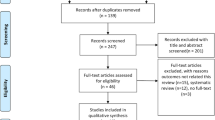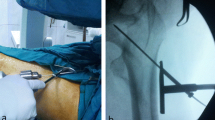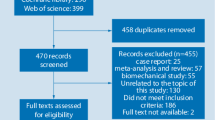Abstract
Background
The dynamic hip screw (DHS) is a common device used in the fixation of hip fractures. Traditionally, this involves the use of a four-hole side plate. Reducing the length of the side plate would theoretically reduce the amount of surgical exposure required, decrease surgery duration, and decrease perioperative morbidity and mortality. Our study aims to review the current evidence regarding the use of two-hole side plates, their use and potential complications.
Methods
Using PRISMA guidelines, two independent reviewers performed a search to collate the available literature from medical databases PubMed, EMBASE, Web of Science, and the Cochrane library. Only clinical and biochemical studies were included. The reference lists of articles included for full text review were searched for any additional primary or review publications.
Results
Four online libraries were searched, with a combined total of 5344 titles reviewed. Following title, abstract, and full text review, 8 articles were considered suitable for inclusion in qualitative analysis. There was a trend towards equal efficiency between two- and four-hole plates when used in stable fractures in terms of blood loss, failure/revision rates, operative and hospital stay durations, collapse loading testing, maximum stress, and fragment migration.
Conclusion
The results of this study show that DHS constructs with two- or four-hole side plates have comparable outcomes when used in patients with stable fracture patterns. However, the majority of the clinical data regarding the use of two-hole DHS plates come from retrospective case series; further prospective, randomised control trials would be of significant benefit.
Level of evidence
Level II; systematic review of all levels of evidence

Similar content being viewed by others
References
Cooper C, Campion G, Melton LJ (1992) Hip fractures in the elderly: a world-wide projection. Osteoporosis Int 2(6):285–289
Bhandari M, Tornetta P, Hanson B et al (2009) Optimal internal fixation for femoral neck fractures: multiple screws or sliding hip screws? J Orthop Trauma 23(6):403–407
Gallagher JC, Melton LJ, Riggs BL et al (1980) Epidemiology of fractures of the proximal femur in Rochester Minnesota. Clin Orthop 150:163–167
Aharonoff GB, Koval KJ, Skovron ML, Zuckerman JD (1997) Hip fractures in the elderly: predictors of one-year mortality. J Orthop Trauma 11:162–165
Richmond J, Aharonoff GB, Zuckerman JD et al (2003) Mortality risk after hip fracture. J Orthop Trauma 17(SUPPLEMENT):S2–S5
National Office of Clinical Audit (2018) Irish Hip Fracture Database National Report 2017. National Office of Clinical Audit, Dublin
Jensen JS (1980) Classification of trochanteric fractures. Acta Orthop Scand 51(1–6):803–810
Van Embden D, Rhemrev SJ, Meylaerts SAG et al (2010) The comparison of two classifications for trochanteric femur fractures: the AO/ASIF classification and the Jensen classification. Injury 41(4):377–381
Parker MJ, Pryor GA (1996) Gamma versus DHS nailing for extracapsular femoral fractures. Int Orthop 20(3):163–168
Clawson DK (1964) Trochanteric fractures treated by the sliding screw plate fixation method. J Trauma 4:737–752
Rao JP, Banzon MT, Weiss AB et al (1983) Treatment of unstable intertrochanteric fractures with anatomic reduction and compression hip screw fixation. Clin Orthop 175:65–71
Doppelt SH (1980) The sliding compression screw - today’s best answer for stabilization of intertrochanteric hip fractures. Orthop C/in North Am; 1
Lee YS, Huang HL, Lo TY et al (2007) Dynamic hip screw in the treatment of intertrochanteric fractures: a comparison of two fixation methods. Int Orthop 31(5):683–688
Yian EH, Banerji I, Matthews LS (1997) Optimal side-plate fixation for unstable intertrochanteric hip fractures. J Orthop Trauma 11(4):254–259
Olsen M, Goshulak P, Crookshank MC et al (2018) Biomechanical testing of a 3-hole versus a 4-hole sliding hip screw in the presence of a retrograde intramedullary nail for ipsilateral intertrochanteric and femur shaft fractures. J Orthop Trauma 32(8):419–424
Baird R, O’Brien P, Cruickshank D (2014) Comparison of stable and unstable pertrochanteric femur fractures managed with 2- and 4-hole side plates. Can J Surg 57(5):327–330
DiPaola M, Razbruch SR, Helfet DL (2004) Minimal incision technique using a two-hole plate for fixation of stable intertrochanteric hip fractures. Orthopaedics 27(3):270–274
Laohapoonrungsee A, Arpornchayanon O, Phornputkul C (2005) Two-hole side-plate DHS in the treatment of intertrochanteric fracture: results and complications. Injury 36(11):1355–1360
Watson A, Zhang Y, Beattie S et al (2012) Prospective randomized controlled trial comparing dynamic hip screw and screw fixation for undisplaced subcapital hip fractures. ANZ J Surg 83(9):679–683
Verhofstad MHJ, Van Der Werken C (2004) DHS osteosynthesis for stable pertrochanteric femur fractures with a two-hole side plate. Injury 35(10):999–1002
Peleg E, Mosheiff R, Liebergall M et al (2006) A short plate compression screw with diagonal bolts—a biomechanical evaluation performed experimentally and by numerical computation. Clin Biomech 21(9):963–968
Rog D, Grigsby P, Hill Z et al (2017) A biomechanical comparison of the two- and four-hole side-plate dynamic hip screw in an osteoporotic composite femur model. J Orthop Surg 25(2):230949901771719
McLoughlin S, Wheeler D, Rider J, Bolhofner B (2000) Biomechanical evaluation of the dynamic hip screw with two- and four-hole side plates. J Orthop Trauma 14(5):318–323
Leung F, Gudushauri P, Yuen G et al (2012) Dynamic hip screw blade fixation for intertrochanteric hip fractures. J Orthop Surg 20(3):302–306
Lee YS, Chen SH, Tsuang YH et al (2008) Internal fixation of undisplaced femoral neck fractures in the elderly: a retrospective comparison of fixation methods. J Trauma 64(1):155–162
Kokoroghiannis C, Aktselis I, Deligeorgis A et al (2012) Evolving concepts of stability and intramedullary fixation of intertrochanteric fractures—a review. Injury 43(6):686–693
Müller ME, Koch P, Nazarian S et al (1990) The comprehensive classification of fractures of long bones. https://doi.org/10.1007/978-3-642-61261-9
Andersen E, Jørgensen LG, Hededam LT (1990) Evans’ classification of trochanteric fractures: an assessment of the interobserver and intraobserver reliability. Injury 21(6):377–378
Pervez H, Parker MJ, Pryor GA, Lutchman L, Chirodian N (2002) Classification of trochanteric fracture of the proximal femur: a study of the reliability of current systems. Injury 33(8):713–715
Alobaid A, Harvey EJ, Elder GM et al (2004) Minimally invasive dynamic hip screw. J Orthop Trauma 18(4):207–212
Říha D, Bartoníček J (2009) Internal fixation of pertrochanteric fractures using DHS with a two-hole side-plate. Int Orthop 34(6):877–882
Author information
Authors and Affiliations
Corresponding author
Ethics declarations
Conflict of interest
The authors declare that they have no conflict of interest.
Additional information
Publisher’s note
Springer Nature remains neutral with regard to jurisdictional claims in published maps and institutional affiliations.
Rights and permissions
About this article
Cite this article
Davey, M.S., Flynn, S.O., Hayes, J. et al. Two-hole versus four-hole plate dynamic hip screw: a systematic review of current evidence. Ir J Med Sci 189, 1317–1322 (2020). https://doi.org/10.1007/s11845-020-02184-9
Received:
Accepted:
Published:
Issue Date:
DOI: https://doi.org/10.1007/s11845-020-02184-9




